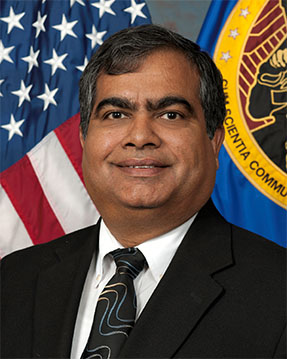Humans in Extreme Ballistic Environments: Towards Improved
Soldier Protection
Sikhanda Statpathy
Army Research Laboratory
Wed, September 19, 2018 - 4:00 PM
Karl Herzfeld Auditorium of Hannan Hall - Rm 108
 Current personal protective equipment (PPE) have drastically reduced battlefield fatalities by using high performance materials to effectively defeat common threats. One approach to reduce battlefield injuries is to further optimize the performance of PPE; however this optimization is limited by our understanding of the human body’s response to the ballistic environment. Expansion of protection strategy to include human effects requires understanding the interaction of human tissues and organs with transmitted ballistic loads, and correlating their mechanical response with injury mechanisms. In pursuit of this goal, a combination of approaches are required, such as investigation with surrogate systems, as well as assimilation of limited data obtained from the theater. Construction of a transfer function to relate these data to a living human necessitates development of accurate modeling and simulation tools. Material models to capture deformation and damage of biological materials under ballistic loading conditions are not available, and simulation approaches for load transfer through these materials demonstrating multi-scale, multi-physics behavior need to be developed. Load transfer through the PPE including novel composites, ceramics and distended structures also need to be understood. The advancement in novel sensors, experimental approaches and high performance computing resources herald a new paradigm in protection science to maximize soldier effectiveness not only by minimizing injury and incapacitation, but also by optimizing protection systems to enhance soldier effectiveness and survivability.
Current personal protective equipment (PPE) have drastically reduced battlefield fatalities by using high performance materials to effectively defeat common threats. One approach to reduce battlefield injuries is to further optimize the performance of PPE; however this optimization is limited by our understanding of the human body’s response to the ballistic environment. Expansion of protection strategy to include human effects requires understanding the interaction of human tissues and organs with transmitted ballistic loads, and correlating their mechanical response with injury mechanisms. In pursuit of this goal, a combination of approaches are required, such as investigation with surrogate systems, as well as assimilation of limited data obtained from the theater. Construction of a transfer function to relate these data to a living human necessitates development of accurate modeling and simulation tools. Material models to capture deformation and damage of biological materials under ballistic loading conditions are not available, and simulation approaches for load transfer through these materials demonstrating multi-scale, multi-physics behavior need to be developed. Load transfer through the PPE including novel composites, ceramics and distended structures also need to be understood. The advancement in novel sensors, experimental approaches and high performance computing resources herald a new paradigm in protection science to maximize soldier effectiveness not only by minimizing injury and incapacitation, but also by optimizing protection systems to enhance soldier effectiveness and survivability.
Refreshments served at 3:45 PM
If you have any questions about the Colloquium Series or would like to make a donation please contact Adrienne Black, black@cua.edu or (202) 319-5315.
